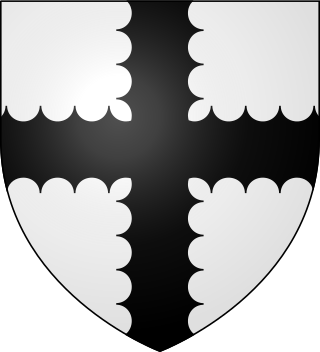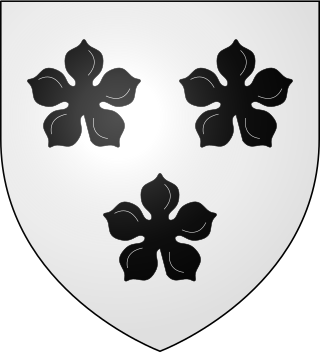
Malcolm IV, nicknamed Virgo, "the Maiden" was King of Scotland from 1153 until his death. He was the eldest son of Henry, Earl of Huntingdon and Northumbria and Ada de Warenne. The original Malcolm Canmore, a name now associated with his great-grandfather Malcolm III, succeeded his grandfather David I, and shared David's Anglo-Norman tastes.
Justiciar is the English form of the medieval Latin term justiciarius or justitiarius. During the Middle Ages in England, the Chief Justiciar was roughly equivalent to a modern Prime Minister of the United Kingdom, as the monarch's chief minister. Similar positions existed in continental Europe, particularly in Norman Italy and in the Carolingian Empire.

Roger de Quincy, 2nd Earl of Winchester, hereditary Constable of Scotland, was a nobleman of Anglo-Norman and Scottish descent who was prominent in both England and Scotland, at his death having one of the largest baronial landholdings in the two kingdoms.
The Provisions of Oxford were constitutional reforms developed during the Oxford Parliament of 1258 to resolve a dispute between King Henry III of England and his barons. The reforms were designed to ensure the king adhered to the rule of law and governed according to the advice of his barons. A council of fifteen barons was chosen to advise and control the king and supervise his ministers. Parliament was to meet regularly three times a year.
Hugh Bigod was Justiciar of England from 1258 to 1260. He was a younger son of Hugh Bigod, 3rd Earl of Norfolk.

Walter de Burgh, 1st Earl of Ulster, 2nd Lord of Connaught also spelt Burke or Bourke, was an Irish peer from the House of Burgh.
Hugh de Puiset was a medieval Bishop of Durham and Chief Justiciar of England under King Richard I. He was the nephew of King Stephen of England and Henry of Blois, who both assisted Hugh's ecclesiastical career. He held the office of treasurer of York for a number of years, which led him into conflict with Henry Murdac, Archbishop of York. In 1153, Hugh was elected bishop of Durham despite the opposition of Murdac.
Uhtred mac Fergus was Lord of Galloway from 1161 to 1174, ruling jointly with his brother Gille Brigte (Gilbert). They were sons of Fergus of Galloway; it was believed that they were half brothers, but Duncan of Carrick was addressed as cousin by the English King, as was Uchtred.. Their mother's name is not known for sure, but she must have been one of the many illegitimate daughters of Henry I of England, most likely Elizabeth Fitzroy.

Donnchadh was a Gall-Gaidhil prince and Scottish magnate in what is now south-western Scotland, whose career stretched from the last quarter of the 12th century until his death in 1250. His father, Gille-Brighde of Galloway, and his uncle, Uhtred of Galloway, were the two rival sons of Fergus, Prince or Lord of Galloway. As a result of Gille-Brighde's conflict with Uhtred and the Scottish monarch William the Lion, Donnchadh became a hostage of King Henry II of England. He probably remained in England for almost a decade before returning north on the death of his father. Although denied succession to all the lands of Galloway, he was granted lordship over Carrick in the north.

Dervorguilla of Galloway was a 'lady of substance' in 13th century Scotland, the wife from 1223 of John, 5th Baron de Balliol, and mother of John I, a future king of Scotland.

The High Middle Ages of Scotland encompass Scotland in the era between the death of Domnall II in 900 AD and the death of King Alexander III in 1286, which was an indirect cause of the Wars of Scottish Independence.

Alexander Comyn, 2nd Earl of Buchan was a Scoto-Norman magnate who was one of the most important figures in the 13th century Kingdom of Scotland. He was the son of William Comyn, jure uxoris Earl of Buchan, and Marjory, Countess of Buchan, the heiress of the last native Scottish Mormaer of Buchan, Fergus. He was the chief counsellor of Alexander III, King of Scots for the entire period of the king's majority and, as Scotland's leading magnate, played a key role in safeguarding the independence of the Scottish monarchy. During his long career, Alexander Comyn was Justiciar of Scotia (1258–89), Constable of Scotland (1275–89), Sheriff of Wigtown (1263–66), Sheriff of Dingwall (1264–66), Ballie of Inverie and finally, Guardian of Scotland (1286–89) during the first interregnum following the death of Alexander III. In 1284 he joined with other Scottish noblemen who acknowledged Margaret of Norway as the heiress to King Alexander. He died sometime after 10 July 1289.
The Justiciar of Scotia was the most senior legal office in the High Medieval Kingdom of Scotland. Scotia in this context refers to Scotland to the north of the River Forth and River Clyde. The other Justiciar positions were the Justiciar of Lothian and the Justiciar of Galloway.

Alan Hostarius was the son of Thomas de Lundin, a grandson of Gille Críst, Mormaer of Mar. His mother's name is unknown, but she was almost certainly a daughter of Máel Coluim, Mormaer of Atholl, meaning that Alan was the product of two Gaelic comital families.
The Justiciar of Lothian was an important legal office in the High Medieval Kingdom of Scotland.
John Comyn (Cumyn) was Lord of Badenoch in Scotland. He was Justiciar of Galloway in 1258. He held lands in Nithsdale and Tynedale.
The Justiciar of North Wales was a legal office concerned with the government of the three counties in north-west Wales during the medieval period. Justiciar was a title which had been given to one of the monarch's chief ministers in both England and Scotland. Following Edward I of England's conquest of North Wales (1277–1283), the counties of Anglesey, Caernarfonshire and Merioneth were created out of the Kingdom of Gwynedd by the Statute of Rhuddlan in 1284 and placed under direct royal control. The Justiciar of North Wales was responsible for the royal administration in these counties as well as the administration of justice. English law was applied to criminal law, but in other matters Welsh law was allowed to continue.
The Galloway revolt of 1234–1235 was an uprising in Galloway during 1234–1235, led by Tomás mac Ailein and Gille Ruadh. The uprising was in response to the succession of Alan of Galloway, whereby King Alexander II of Scotland ordered Galloway to be divided the amongst Alan's three heiresses under Norman feudal law. This judgement excluded Alan's illegitimate son Tomás, who believed he was the rightful heir under the Gaelic system of tanistry. Alexander II responded by leading an army into Galloway to crush the rebellion. The Scottish army was almost routed, however was saved by the arrival of Fearchar, Earl of Ross and his forces. Walter Comyn, Lord of Badenoch was left to mop up the revolt, however was forced to abandon the region. Patrick II, Earl of Dunbar led another army in 1235, with Adam, Abbot of Melrose, and Gilbert, Bishop of Galloway and forced the submission of Tomás and Gille.

William St. Clair, 6th Baron of Roslin was a Scottish nobleman of the late 13th and early 14th centuries.

Sir Walter de Burghdon, also known as Walter de Burdon, acted as the Constable of Carstairs Castle, the Sheriff of Lanark during 1301-1303 and joint Justiciar of Galloway in 1305.


 and Walter de Burghdon
and Walter de Burghdon  (1305)
(1305)








